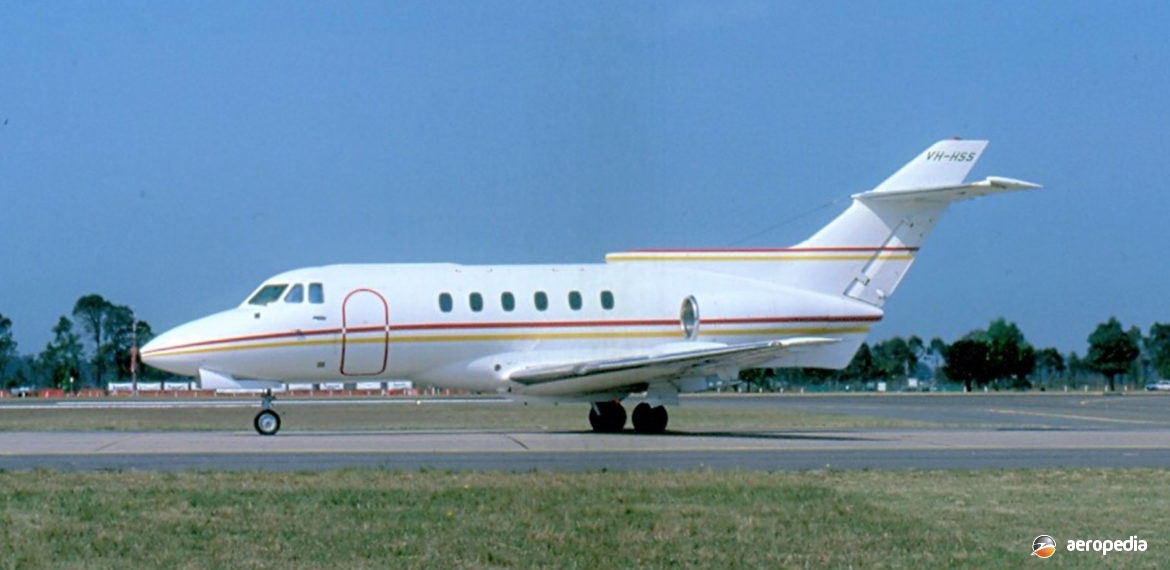Photograph:
Hawker HS-125-700B VH-HSS (c/n 257169) at RAAF Richmond, NSW in October 1988 (David C Eyre)
Country of origin:
United Kingdom
Description:
Business and executive jet aircraft
Power Plant:
Two 3,700 lbst Garrett TFE731-3-1H turbofans
Specifications:
- Wingspan: 14.33 m (47 ft)
- Length: 15.46 m (50 ft 8½ in)
- Height: 5.37 m (17 ft 7 in)
- Wing area: 32.79 m² (353 sq ft)
- Max operating speed: 592 km/h (368 mph)
- Max cruising speed: 796 km/h (495 mph)
- Long-range cruising speed: 722 km/h (449 mph)
- Time to climb to 10,668 m (35,000 ft): 19 mins
- Operating altitude: 12,500 m (41,000 ft)
- Take-off balanced field length: 1,829 m (6,000 ft)
- Landing field length: 1,356 m (4,450 ft)
- Range with 544 kg (1,200 lb) payload and 45 mins reserve: 4,355 km (2,706 miles)
- Fuel capacity: 5,369 litres (1,181 Imp gals)
- Empty weight: 5,772 kg (12,725 lb)
- Max payload weight: 1,057 kg (2,330 lb)
- Loaded weight: 11,113 kg (24,200 lb)
History:
The Hawker Series 600 was introduced to the market in 1971 and was powered by two 3,750 lbst Viper 600 series engines with a two-stage turbine. This model had a fuselage stretch of 0.6 m (2 ft) to enable passenger capacity to be increased from six to eight, or eight to ten. The subsequent fuel crisis coupled with environmental complaints provided further stimulus to improve the aircraft and this led to the Series 700 which was powered by the Garrett TFE731-3 turbofan engines, the new engines providing increased range by some 50 per cent for the same fuel capacity. External noise levels were reduced to comply with internationally accepted levels. British Aerospace at that time offered to re-engine older models and by 1984 some 90 examples had been retrofitted with the new engine by British Aerospace at Chester in Cheshire and by Garrett Air Research in the United States.
The Series 700 had the rear fuselage reshaped to reduce drag and fuel capacity was increased with a ventral tank. New nosewheel doors were fitted, and the fin area was increased. There were six cabin windows per side and the extra cabin length permitted more furnishing options. Two Series 600Bs were delivered to the Royal Air Force (RAF) in 1973 as the Model CC.2.
Development of the type continued. The 125-700 series was introduced in 1976 and had significant performance and fuel economy benefits achieved by the installation of Garrett TFE731-3R-1H turbofans, the first of this model flying on 19 June 1976. These engines offered lower fuel consumption and substantially greater range. The prototype of the Series 700 was by way of conversion of the Series 600 prototype G-AZHS (c/n 25258) and was flown for the first time on 28 June 1975, initial deliveries commencing in May 1977. Two Series 700Bs were delivered to the RAF as the CC.3.
Some 215 examples of this series was built before production switched to the 800 series and the 1000 series.
Examples of early series aircraft registered in Australia have included VH-TOM (c/n 25242), a Series 400B, obtained by a West Australian company, Tom the Cheap, in December 1970 but exported in April 1975 as G-BDKF.
VH-PAB, a Model 400/731 (c/n 25265), operated with Pacific Aviation (Australasia) from February 1990 until September 1995 when it was exported as N150SA.
Model 600B VH-NJA (c/n 256037) was operated by Sherrard Aviation Pty Ltd from November 1989 to August 1992 when it was exported to Premier Airlines as RP-C1600.
In 1981 a 700 Series aircraft made a demonstration tour of this region and a number of examples have operated here over the years, including Mk 700A VH-LYG (c/n 257001) from February 1996 to April 1997 with Orient Pacific Pty Ltd, exported as N257AJ.
Model 700Bs registered have included VH-JCC (c/n 257046), operated by Stillwell Aviation and Hancock Prospecting from February 1984, becoming VH-LRH in November 1985 before being exported in 1994 as XA-LEG.
VH-JFT (c/n 257064) was registered to Stillwell Aviation (Australasia) and Pacific Aviation Australasia from July 1986, Department of Transport and Communications, Civil Aviation Authority, and Air Services Australia, eventually being exported in December 1995 as N395RD.
VH-HSS (c/n 257169 – ex VH-SOA [ntu]) was registered to Shell Company of Australia from June 1982 to June 1997 when it was exported as VR-HSS.
VH-LMP (c/n 257178) was registered from October 1987 to June 1992 with Pacific Aviation Australasia, being exported as G-5-747.
VH-HSP (c/n 257215) was registered in November 1984 and operated with Westfield Ltd, and then Coles Myer Ltd, before being exported as VT-OBE.

